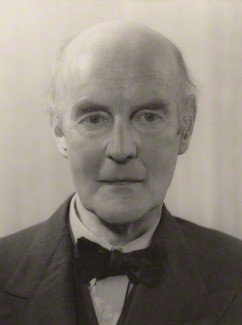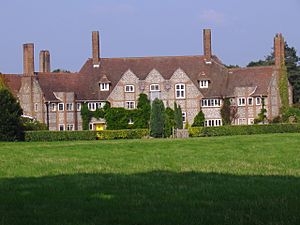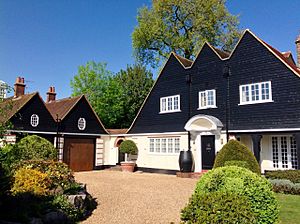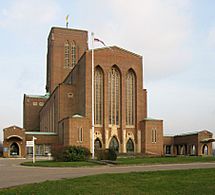Edward Maufe facts for kids
Sir Edward Brantwood Maufe (born December 12, 1882 – died December 12, 1974) was an English architect and designer. He created many different buildings, including homes, shops, and public buildings. He is best known for his work on churches and memorials. Two of his most famous designs are Guildford Cathedral and the Air Forces Memorial. He received the Royal Gold Medal for architecture in 1944. In 1954, he was knighted for his important work with the Commonwealth War Graves Commission. He worked with this group from 1943 until he passed away.
Contents
About Edward Maufe
His Early Life and Start in Architecture
Edward Maufe was born Edward Muff in Ilkley, Yorkshire, on December 12, 1882. He was the second of three children. His father, Henry Muff, owned part of a large department store called Brown Muff & Co. This store was so grand it was known as "the Harrods of the North." His mother, Maude Alice Muff, was related to Titus Salt, who founded the famous village of Saltaire.
Edward went to Wharfedale School and then Bradford Grammar School. When he was a teenager, he became very interested in architecture. In 1899, he moved to London to train with architect William A. Pite for five years. Around this time, his family moved to Red House in Bexleyheath. This house was designed by Philip Webb for William Morris. Maufe later said this house greatly influenced his own architectural ideas.
After his training in 1904, Maufe studied at St John's College, Oxford, and the Architectural Association School of Architecture. In 1909, his family changed their last name from Muff to Maufe. The next year, in 1910, Edward Maufe married Prudence Stutchbury. She was an interior designer and later worked for a famous furniture store called Heal's.
Maufe During the Wars
During the First World War, Maufe served in the Royal Naval Volunteer Reserve. Later, in 1917, he joined the army and served in Salonika. He left the army in 1919. In 1920, he became a fellow of the Royal Institute of British Architects (RIBA).
In 1940, a painter named Gluck painted a portrait of Maufe. The painting shows him with his winning design for Guildford Cathedral. Maufe had designed Gluck's studio in 1932. Another portrait of him is kept at the National Portrait Gallery, London.
Maufe's Architectural Designs
Maufe's first major project after starting his own architecture firm was Kelling Hall in Norfolk in 1912. This building showed his early connection to the Arts and Crafts movement. It had a unique "butterfly plan" and walls made of flint. Before this, in 1909, he designed a weekend house called The Barn for a famous music hall star, Marie Studholme. This house was influenced by other well-known architects.
Maufe also worked on several churches. He decorated St Martin-in-the-Fields and helped restore Church of St John-at-Hackney. These projects helped him become known in church design circles.
In 1924, Maufe's designs for the Palace of Industry at the British Empire Exhibition in Wembley gained attention. He won a silver medal at the Paris Exhibition in 1925, which led to many new projects. He designed churches like St Bede in Clapham (1922) and St Saviour's in Acton (1924). These churches were built for the Royal Association in Aid of the Deaf and Dumb. St Saviour's had a simple style, similar to modern Swedish architecture. Maufe admired Swedish architecture and often spoke about how it combined new ideas with old traditions.
Designing Guildford Cathedral
In 1932, Maufe won a competition to design Guildford Cathedral. His design was in a Gothic style, using concrete covered with brick. The cathedral was finished in 1961. Many architects admired its exterior, including the main hall (nave) and side aisles. They also liked how Maufe used space inside. He was seen as an architect who truly understood church design. He wanted to create buildings that felt religious and simple, while still connecting to the grand English cathedrals of the past.
In 1936, King George VI asked Maufe to make changes to the Royal Chapel of All Saints in Windsor Great Park. This small private chapel is on the grounds of Royal Lodge, which was the Queen Mother's home. Maufe designed a new ceiling, a royal pew, new choir stalls, and a cover for a new organ. In 1944, he received the Royal Gold Medal for his architectural achievements.
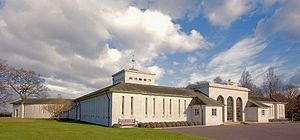
War Memorials and Other Works
From 1943, Maufe became the main architect in the UK for the Commonwealth War Graves Commission. He eventually became their chief architect and artistic advisor until 1969. He designed several war memorials, including expansions to the Tower Hill Memorial and the Air Forces Memorial near Runnymede (1950–53).
Maufe's designs for homes were very modern and stylish for their time. People called his style "modernity with manners." He often wrote and lectured about architecture, especially about furnishing homes. His interior designs used built-in features and soft colors like pink, mauve, and cream. He also used silver-lacquered furniture and mirrors. One of his house designs was Yaffle Hill in Broadstone, Dorset, built in 1929. He also designed parts of Broadcasting House and several Lloyds Bank branches.
Maufe designed buildings for many universities, including Trinity and St John's College, Cambridge, and Balliol and St John's College, Oxford. He also worked on the Cambridge Festival Theatre, St Thomas the Apostle, Hanwell, the Oxford Playhouse, and St Columba's Church, London. After World War II, he helped rebuild parts of Middle Temple, Inner Temple, and Gray's Inn that were damaged by bombs.
An architectural historian named Ian Nairn said that Maufe had "genuine spatial gifts." This means he was very good at designing spaces, even if his style was different from what was popular at the time.
Later Life and Passing
Maufe retired in 1964. He passed away on his 92nd birthday, December 12, 1974, in Uckfield Hospital. His architectural drawings and letters are now kept at the RIBA.
Some of Maufe's Buildings
- The Barn, Laleham, Middlesex (1909)
- Kelling Hall, Norfolk (1912)
- St Bede's, Clapham Road, London SW9 (1924)
- Palace of Industry at the British Empire Exhibition, Wembley (1924–25)
- Lloyds Bank, Wren Road, Camberwell (1925)
- Festival Theatre, Cambridge (alterations only) (1926)
- St Saviour's, Old Oak Lane, Acton London (1926)
- Trinity College, Cambridge (1927)
- Yaffle Hill, Broadstone, Dorset (1929)
- Tower at St Mary's, Liss, Hampshire (1930)
- Lloyds Bank, 50 Notting Hill Gate, London (1930)
- St John's Church, Hook, Hampshire (1931)
- Guildford Cathedral (1932)
- Studio for Religious Services, Broadcasting House, Portland Place (1932)
- Rawlinson Building extension, St John's College, Oxford (1933)
- St Thomas the Apostle, Boston Road, Hanwell, London (1934)
- The House, Round Island, Poole Harbour (around 1935)
- Alterations to Royal Chapel of All Saints in Windsor Great Park (1936)
- Extension to Morley College, London SE1 (1937)
- St John's College, Cambridge Chapel Court and North Court (1938–40)
- The Oxford Playhouse, Oxford (1938)
- Heal's Department Store in Tottenham Court Road, London (Southern extension) (1938)
- St John the Evangelist, London Road, Hook, Hampshire (1938)
- Bishop Hannington Memorial Church, Hove (1938)
- St Andrew's United Reformed Church, Cheam (1939)
- St George's Church, Goodrington, Paignton (1939)
- All Saints Weston, Chestnut Avenue, Esher, Surrey (1939)
- Walworth Methodist Chapel Clubland (1939)
- Northumberland Chapel, St Peter and St Paul Church, Albury, Surrey (1939)
- Chatham Naval Memorial, Chatham, Kent (extension only) (1945)
- Plymouth Naval Memorial, Plymouth, Devon (extension only) (1945)
- The RAF Shelter, Brookwood Cemetery, Surrey (1947)
- Dolphin Quad, St John's College, Oxford (1947)
- Dulwich Picture Gallery post-war restoration (1947–53)
- Commonwealth War Graves Commission cremation memorial, Golders Green Crematorium, London (1949)
- St Mary's Church, Hampden Park, Eastbourne (1952–54)
- Air Forces Memorial, Runnymede, Surrey (1953)
- The Tower Hill Memorial, London (extension only) (1955)
- The Master's House, Temple Church (rebuilding after war damage) (around 1955)
- St Columba's Church, London, Pont Street in London SW1 (1955)
- Crown Row Building, Inner Temple (rebuilding after war damage) (1955)
- St Mary in the Park, Willingdon near Eastbourne (1956)
- Magna Carta Memorial, Runnymede, Surrey (1957)
- Francis Taylor Building, Inner Temple (1957)
- St Alphege's, Lower Edmonton, London (1958)
- The Chapel at Lewes Priory School Mountfield Road, Lewes (1960)
- Cathedral Church of St Peter, Bradford (extension only) (1963)
- St Nicholas' Church, Saltdean (1964)
See also
- Exterior sculpture of Guildford Cathedral


